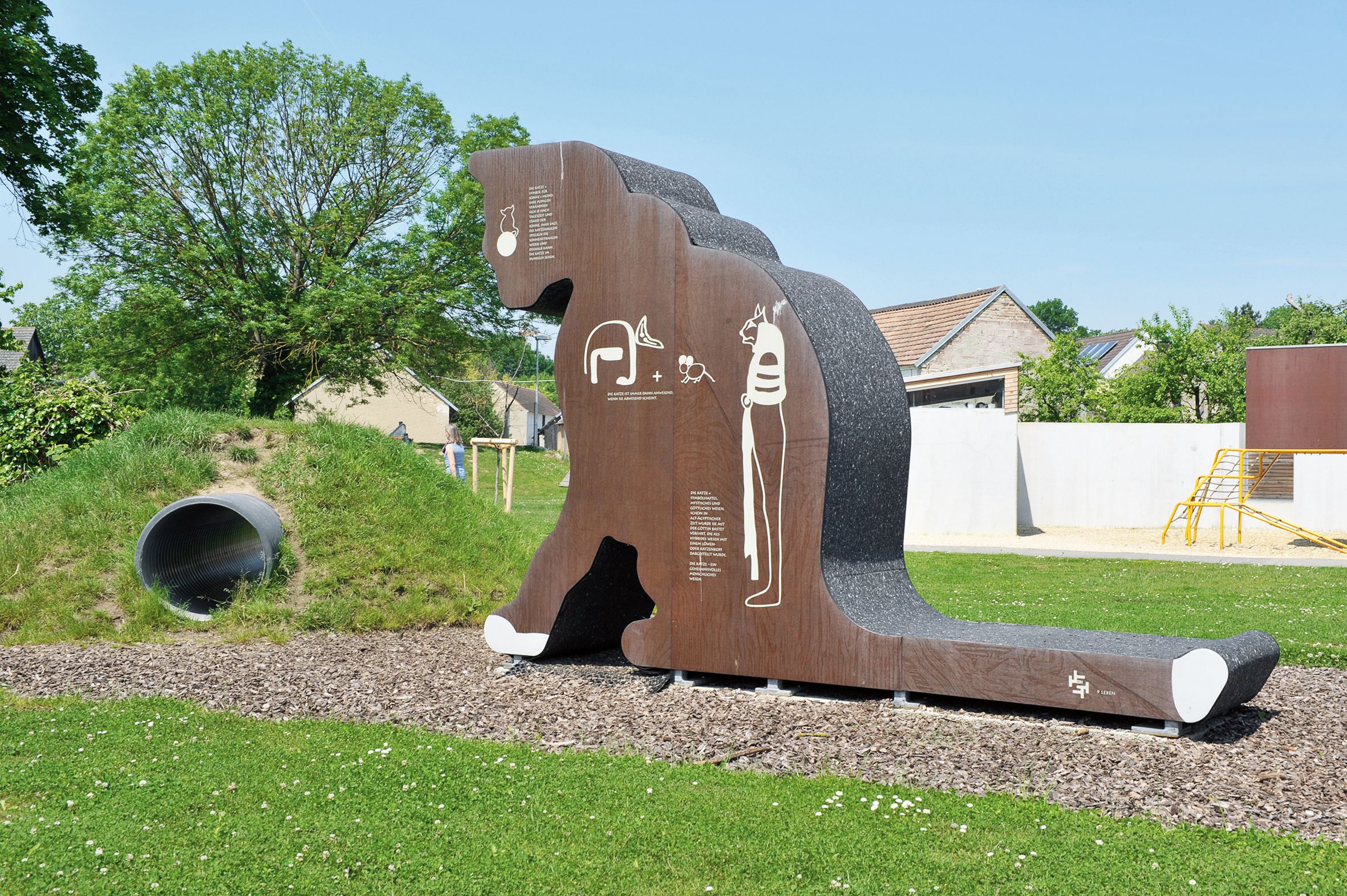Regina Möller
:
Großmugls Katze
Back
Information
Regina Möller is an artist who does not fit into a predetermined category. “My artistic practice oscillates between art and design, sculpture and body, art objects and everyday articles,” says Möller. She works with the most diverse media – including installation, printed material, photography, sound, video, comics, costume design, sculpture, and design. The magazine regina, which she created in the late 1990s, is based on fictional content and represents a combination of art, comics, and everyday life. In it, she questions the social notions of female identity and representation.
For the newly constructed Großmugl kindergarten (designed by Franz Sam), the artist created a three-meter-high, climbable wooden sculpture in the form of a stylized cat. The sculpture embodies a kind of prototypical cat with mysterious characteristics that are the substance of countless folk tales and mythological stories, but it is also an object that can be played with and on one of its sides it has grips for climbing that are especially made for children’s hands. Children can climb up the cat’s side, use its tail to sit or lay down on, or they can slide down its back. Not far from the cat, Regina Möller created a small hill with a tube going through it as a kind of mouse hole. From here, children can observe the cat from the perspective of a mouse. On the cat’s smooth side, Möller inscribed different texts and pictographic drawings about cats. A picture of a cat and a mouse is accompanied by the mysterious inscription: “The cat is always present when it seems to be present.” Another inscription describes the cat as a symbol for the sun and moon. We also learn that Bastet was worshiped by the Egyptians as the goddess of fertility and love and was depicted either as a cat or as a woman with the head of a cat or a lion. Through these anecdotes, the children can interact with the cat sculpture both physically and intellectually. The different forms of information found on the sculpture encourage children to cultivate not only their factual knowledge, but also their imagination.
Parallel to her installation at the kindergarten, Regina Möller also produced a sketch book titled … für die Katz (For the Cat), which she described as “a small homage to the cat in each of us.” The book is not a “scientific or historical treatise,” as the preface makes clear. The book has the appearance of a catalogue with collages of texts and images. It includes not only prototypical product designs by the artist, but an associative collection of drawings, fables, theories, stories about the essence of the cat and its symbolic meaning, and a short story by Alfred Hitchcock. It also includes drawings and stories by the children in the kindergarten, while Möller also presents embodiment, her label for which she designs clothes, wallpaper, furniture, and interiors that play with the distinctions between art and design. In psychology, the term “embodiment” is often used to refer to the interdependency between the body and the psyche. It is the connection between the body and its social environment that Regina Möller explores with her label. She not only charges the products she designs with new meanings; following in the artistic tradition of the Bauhaus, she also combines the need for products to be useful with an artistic “uselessness.” As the artist has said: “Each product-artwork is a prototype of a piece of furniture or clothing that is a sculpture at the same time.” In 1997, for example, she manufactured a summer dress made of Tyvek packaging material that was held together only with pins, thus leaving it open as to how it will be used – whether as an artwork behind glass, or as a piece of clothing. At the same time as she was working on Großmugls Katze, Möller also designed the piece of furniture Katze-Prototyp (Cat Prototype), which is based on the same form and can be used as a chair or as a table for a small child. The material and surface design can vary, according to the user’s desires. When Regina Möller made her first climbable sculpture for the old kindergarten in Großmugl in 2001, she asked the children to make drawings about where they liked to play the most. She then used these to create a climbing structure with a house on top resembling a cardboard box. The interior is coated with washable green blackboard paint. On its exterior are the words “living room” and “children’s room” in many languages, conveying a sense of multiculturalism to the kids.
It would be misleading to assume that Regina Möller pursues the Bauhaus aim of returning to traditional crafts, thereby aestheticizing everyday life. Rather, she regards art as a social and participatory practice for which categories like “art” and “everyday life” are superfluous.




